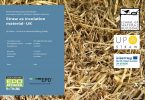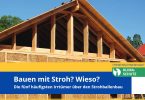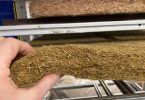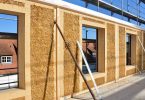EN: With the project “Straw bale construction 2012 – 2013. Extended approval, quality assurance, straw construction guideline”, a clear reference framework for users was developed for straw construction in Germany. Building with straw has thus become an attractive, selectable and technically safe alternative to conventional construction methods. The project was divided into two work packages. On the one hand, the existing general building authority approval was to be extended and with it the range of application of this construction method with renewable raw materials. The optimisation of the manufacturing process and quality assurance were to flank the extension of the approval. On the other hand, the elaboration of a straw construction guideline should enable the professional implementation in the area and form the basis of professional training. Overall, the project results should considerably improve the marketability of this construction method and strengthen all players in straw construction. The scientific and technical work objectives of this project covered the entire spectrum for which the introduction and further development of this building material made from renewable raw materials is necessary: Re-evaluation of the resistance of straw to microbial effects according to the current state of knowledge Evaluation of the building component claddings inside and outside to optimise the building physical properties, with special consideration of the directly plastered type of execution Redefinition of the suitability range of straw building components according to the new evaluations Extension of the building authority approval Optimisation of the production process of straw bales suitable for building materials in agriculture Creation of a secured application framework (straw building guideline).
DE: Mit dem Projekt „Strohballenbau 2012 – 2013. Erweiterte Zulassung, Qualitätssicherung, Strohbaurichtlinie“ wurde für die Strohbauweise in Deutschland ein klarer Bezugsrahmen für Anwender erarbeitet. Das Bauen mit Stroh ist damit eine attraktive, wählbare und technisch sichere Alternative zu herkömmlichen Bauweisen geworden. Das Vorhaben war in zwei Arbeitspakete untergliedert. Zum einen sollte die bestehende all- gemeine bauaufsichtliche Zulassung erweitert werden und damit auch der Anwendungsbe- reich dieser Bauweise mit nachwachsenden Rohstoffen. Die Optimierung des Herstellungs- prozesses und die Qualitätssicherung sollten als Voraussetzung die Erweiterung der Zulassung flankieren. Zum anderen sollte die Ausarbeitung einer Strohbaurichtlinie die fachgerechte Umsetzung in der Fläche ermöglichen und die Grundlage von fachgerechten Schulungen bil- den. Insgesamt sollte durch das Projektergebnis die Vermarktbarkeit dieser Bauweise erheb- lich verbessert werden und sämtliche Akteure im Strohbau stärken. Die wissenschaftlichen und technischen Arbeitsziele dieses Projektes erfassten das gesamte Spektrum, für das eine Einführung und Weiterentwicklung dieses Baustoffs aus nachwachsen- den Rohstoffen notwendig ist: Neubewertung der Resistenz von Stroh gegen mikrobiellen Einwirkungen nach dem aktuellen Stand des Wissens Bewertung der Bauteilbekleidungen innen und außen zur Optimierung der bauphysikalischen Eigenschaften, bei besonderer Berücksichtigung der direkt verputzten Ausführungsart Neudefinition des Tauglichkeitsbereichs von Strohbauteilen gemäß den neuen Bewertungen Erweiterung der bauaufsichtlichen Zulassung Optimierung des Herstellungsprozesses von baustoffgeeigneten Strohballen in der Landwirtschaft Schaffung eines abgesicherten Anwendungsrahmens (Strohbaurichtlinie)
Authors: Sissy Hein; Benedikt Kaesberg; Dirk Scharmer; Burkard Rüger; Sabine Sühlo







